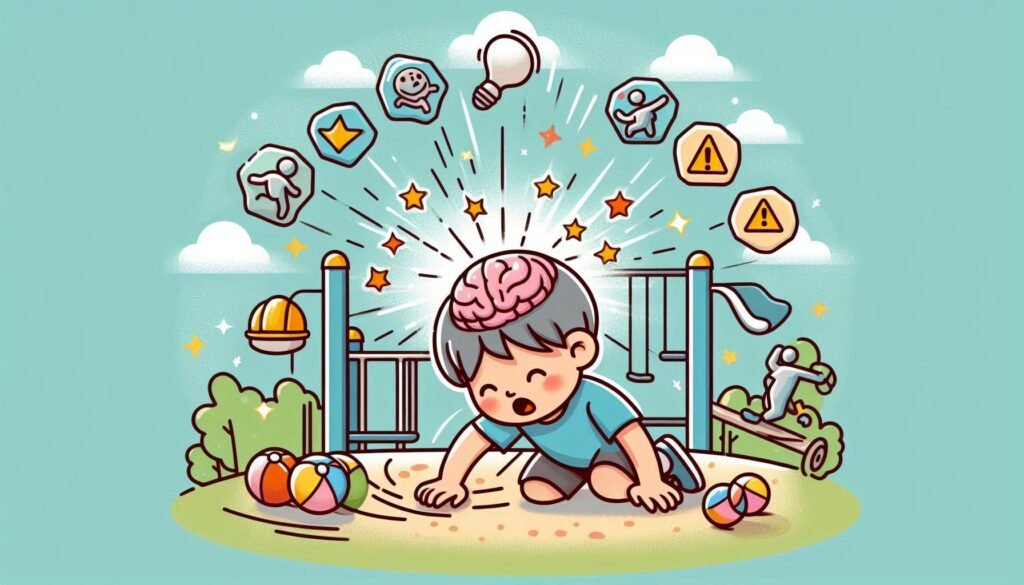Concussions are often dismissed as mere bumps on the head, but their consequences can be far more severe than many realize. Among these, Secondary Impact Syndrome (SIS) stands out as a rare yet potentially fatal condition that arises from repeated concussions. Athletes and active individuals might feel invincible, pushing through injuries for the love of the game or sport. However, this mindset can lead to disastrous outcomes if they don’t understand the dangers associated with SIS.
As we delve deeper into this alarming syndrome, it’s essential to grasp what makes it so perilous. The brain’s vulnerability after an initial concussion is significant; sustaining another impact during this sensitive period could trigger rapid swelling and catastrophic damage. This blog will explore everything from the science behind SIS to real-life case studies and prevention strategies.
Understanding Secondary Impact Syndrome isn’t just crucial for athletes—it’s vital for coaches, parents, and anyone involved in sports or physical activities. Awareness is key to safeguarding against such threats lurking within seemingly harmless impacts. Let’s uncover how we can protect our brains while enjoying our favorite sports safely!

Defining Secondary Impact Syndrome: A Rare but Deadly Condition
Secondary Impact Syndrome (SIS) is a rare but life-threatening condition that occurs when an individual sustains a second concussion before fully recovering from the first. This rapid succession of impacts can lead to severe brain swelling and potentially fatal consequences.
Typically seen in athletes, SIS often arises during contact sports like football, hockey, and soccer. The risk increases dramatically within days or weeks after an initial head injury when the brain is still vulnerable. Unfortunately, many young athletes may not recognize their symptoms or feel pressured to return to play.
The exact mechanisms behind SIS are complex and involve disruptions in cerebral blood flow and increased intracranial pressure. Such physiological changes can result in catastrophic outcomes if not promptly addressed.
Though relatively uncommon, the tragic nature of SIS highlights its seriousness—a reminder that even seemingly minor concussions warrant attention. Awareness of this condition could save lives by prompting immediate medical evaluation for any subsequent head injuries sustained during recovery periods.
The Pathophysiology of Rapid Brain Swelling in SIS
Secondary Impact Syndrome (SIS) is characterized by a rapid and often catastrophic brain swelling that can occur after an individual sustains multiple concussions within a short time frame. The condition arises when the brain, already compromised from an initial injury, is subjected to additional trauma. This recurring impact may lead to severe neurological consequences.
The pathophysiology behind SIS involves complex mechanisms of cellular disruption and inflammation. Following the first concussion, there are alterations in neuronal function and metabolic processes that leave the brain vulnerable. When a second impact occurs, it can trigger a cascade of neuroinflammation.
This inflammatory response leads to increased intracranial pressure as fluid accumulates in the brain tissue. As pressure builds up rapidly, critical functions such as blood flow become impaired, exacerbating potential damage.
Understanding this biological reaction is vital for recognizing why SIS poses such significant risks. The fragile state of an injured brain makes it particularly susceptible to further injuries during recovery phases.
Identifying High-Risk Periods Following Initial Concussion
After an initial concussion, the brain enters a vulnerable state. This period is critical for recovery and can last anywhere from days to weeks. During this time, the risk of sustaining another concussion increases significantly. Athletes must be especially cautious as engaging in physical activity too soon can lead to devastating consequences.
Monitoring symptoms closely immediately after a concussion is essential. Signs like headaches, dizziness, or confusion should not be ignored. These symptoms indicate that the brain has not fully healed and may still be susceptible to injury.
High-risk periods typically extend up to 10 days following the first concussion but can vary among individuals based on factors such as age and health history. Coaches and medical professionals should track return-to-play timelines meticulously during this phase.
Education about these high-risk windows plays a crucial role in ensuring safety. Athletes need awareness surrounding their vulnerability post-injury so they might prioritize proper healing before returning to demanding activities.
Symptoms and Warning Signs of Impending Secondary Impact Syndrome
Recognizing the symptoms of Secondary Impact Syndrome (SIS) can be crucial for ensuring athlete safety. After an initial concussion, individuals may exhibit subtle changes that warrant immediate attention. Common signs include confusion and disorientation, which can progress rapidly if another impact occurs.
Headaches that worsen in intensity are also a red flag. These intense headaches often differ from typical post-concussion discomfort and may indicate serious complications ahead. Behavioral changes such as irritability or mood swings might emerge, indicating neurological distress.
Physical symptoms like dizziness or balance issues can further complicate recovery after a concussion. These indicators suggest that the brain is struggling to cope with stressors following trauma.
Additionally, nausea and vomiting should not be overlooked; they could signal increased intracranial pressure associated with SIS. Timely intervention at this stage is vital for preventing irreversible damage and safeguarding long-term health.
The Crucial Role of Proper Concussion Management in Preventing SIS
Proper concussion management is vital in safeguarding athletes from the risks associated with Secondary Impact Syndrome (SIS). When an individual suffers a concussion, their brain is already vulnerable. The importance of monitoring symptoms and allowing adequate recovery time cannot be overstated.
Athletes often face pressure to return to play quickly. This can lead to premature participation before full healing has occurred. Rigorous protocols must be established within sports organizations to ensure that any signs of concussion are taken seriously, promoting a culture of safety over competitiveness.
Educating coaches, players, and parents about the dangers of repeated concussions plays a significant role in effective management. Awareness enhances vigilance toward recognizing symptoms that may indicate an athlete should not resume physical activity.
Establishing clear guidelines for assessment and treatment is essential. Healthcare professionals need access to comprehensive resources for evaluating concussions and determining when it’s safe for athletes to return without risking SIS or other complications related to head injuries.
Case Studies: Lessons Learned from Documented SIS Incidents
Case studies of Secondary Impact Syndrome (SIS) incidents reveal critical lessons that can enhance our understanding of its dangers. One notable case involved a high school athlete who sustained multiple concussions within a short time frame. Despite experiencing symptoms, he was cleared to return to play and subsequently developed SIS. This incident underscored the importance of recognizing signs of concussion and adhering strictly to recovery protocols.
Another documented case examined an amateur football player who suffered a second collision shortly after his first concussion. He exhibited severe headaches and confusion but continued playing. Tragically, this led to catastrophic brain swelling, highlighting the dire consequences of ignoring medical advice.
These cases emphasize the need for vigilant monitoring during recovery periods following head injuries. They also stress the importance of educating athletes, coaches, and parents about SIS risks.
By analyzing such incidents, we gather valuable insights into prevention strategies that can save lives and protect future generations from similar fates.
Return-to-Play Protocols: Safeguarding Against Secondary Impacts
Return-to-play protocols are essential in preventing secondary impact syndrome. These guidelines help ensure that athletes recover fully from a concussion before resuming sports activities. A phased approach is critical, allowing the brain to heal adequately without risking further injury.
Typically, the protocol begins with physical and cognitive rest. Athletes must avoid any activity that could exacerbate symptoms during this phase. Only when they are symptom-free can they gradually progress through stages of increased exertion, monitored closely by medical professionals.
Each step in the protocol should be taken cautiously. If symptoms reappear at any stage, it’s vital to return to the previous level of care until full recovery is achieved again. Open communication between players, coaches, and healthcare providers plays a crucial role in this process.
Education on these protocols is equally important for all involved—parents, trainers, and teammates alike. Understanding their significance can dramatically reduce risks associated with repeated concussions and make sports safer for everyone involved.
Education and Awareness: Key to Preventing Tragic Outcomes
Education and awareness play a pivotal role in preventing secondary impact syndrome (SIS). Athletes, coaches, parents, and medical staff must understand the risks associated with repeated concussions. Knowledge about SIS can foster vigilance during the recovery process.
Workshops and seminars can provide valuable information on recognizing concussion symptoms. When individuals are educated on how to identify these signs early, they are better equipped to make informed decisions regarding an athlete’s health. This proactive approach is essential for safeguarding players.
Moreover, awareness campaigns should focus on promoting safe sports practices. By encouraging open discussions about brain injuries, we can eliminate stigma around reporting symptoms. Creating an environment where athletes feel comfortable speaking up is crucial.
Collaboration between schools and sports organizations enhances education efforts. Integrating concussion management protocols into training programs ensures that everyone understands their responsibilities. With collective knowledge and shared responsibility, we can significantly reduce the risk of tragic outcomes related to SIS.
Legal and Ethical Considerations in SIS Prevention
The legal and ethical landscape surrounding Secondary Impact Syndrome (SIS) prevention is complex. As awareness grows about the risks of repeated concussions, so too does the responsibility of coaches, athletic organizations, and medical personnel to safeguard athletes. Negligence in recognizing symptoms or allowing a player to return prematurely can lead to severe consequences.
Legal accountability often hinges on established protocols for concussion management. Organizations must implement comprehensive policies that prioritize athlete safety over competitive pressure. Failing to do so could result in lawsuits from families affected by SIS outcomes.
Ethically, it’s crucial for stakeholders to foster an environment where players feel safe reporting injuries without fear of losing their positions. Transparent communication regarding risks empowers athletes and promotes informed decision-making.
Education plays a pivotal role in this context as well. Training programs for coaches and staff help ensure they understand the signs of concussion and SIS risk factors, ultimately creating safer sports environments for everyone involved.
Research Directions in Secondary Impact Syndrome Prevention
As the understanding of Secondary Impact Syndrome (SIS) evolves, research plays a critical role in prevention and management strategies. Current studies focus on identifying biomarkers that could predict susceptibility to SIS. This can help medical professionals intervene earlier, potentially saving lives.
Investigations into neuroprotective agents are also underway. These agents may offer defense against brain swelling after a second concussion occurs too soon following an initial injury. Furthermore, advanced imaging techniques are being explored to better visualize changes in brain structure post-concussion.
Education remains vital in research directions as well. Studies examining the effectiveness of concussion awareness programs for athletes, coaches, and parents are essential for fostering safer sports environments.
Collaborative efforts between researchers, healthcare providers, and athletic organizations will be crucial moving forward. By sharing findings and best practices widely within communities involved with contact sports, we can significantly reduce the risks associated with repeated concussions.
Continuous funding for SIS-related research ensures progress toward more effective prevention methods—a necessity if we aim to protect future generations from this rare but dangerous condition.


